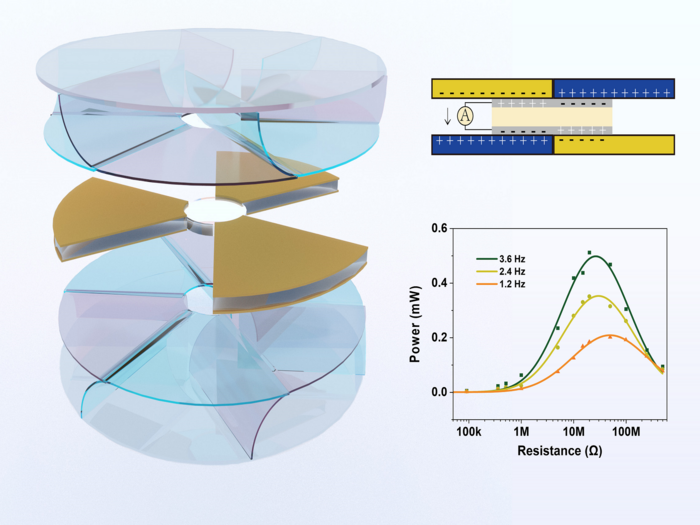Reviewed by Mila PereraOct 28 2022
Static electricity, or the energy produced when two surfaces rub against one another, is known as triboelectric energy. After being split apart, electrons are transferred between the two surfaces, charging one of them.
 This diagram shows the schematic of the constant inherent capacitance triboelectric nanogenerator, the working mechanism of the device with two surfaces rubbing against each other, and the output powers of the device. Image Credit: Nano Research
This diagram shows the schematic of the constant inherent capacitance triboelectric nanogenerator, the working mechanism of the device with two surfaces rubbing against each other, and the output powers of the device. Image Credit: Nano Research
Triboelectric generators are mechanical energy harvesters that use the friction between two surfaces to create electricity. These tiny power plants can power sensors, wearable electronics, and other cutting-edge technologies.
In a recent study, researchers propose a new approach for creating triboelectric nanogenerators with a constant intrinsic capacitance. These nanogenerators now employ a time-dependent intrinsic capacitance, but research indicates that changing this could improve their energy conversion efficiency.
Nano Research published the study on October 26th, 2022.
Triboelectric nanogenerators can provide a feasible way to convert mechanical energy into electricity. With improved efficiency and sensitivity, even very weak mechanical energy ‘hidden’ in the environment can be caught and utilized.
Youfan Hu, Professor, School of Electronics at Peking University
The capacitor of a nanogenerator can store electric charges due to its capacitance. Researchers first created a mathematical model to examine the potential of triboelectric nanogenerators with constant inherent capacitance to show that the capacitance might function.
The scientists then created a prototype of the nanogenerator to evaluate its performance and compare it with currently available time-dependent inherent capacitance.
The capacitors were charged using three different types of power conditioning circuits to test the effectiveness of the two separate triboelectric nanogenerators.
The researchers discovered that both triboelectric nanogenerators performed better on a full wave power circuit. However, the constant inherent capacitance nanogenerators could store around twice as much charge as the time-dependent inherent capacitance nanogenerators.
This has a significant benefit for the constant inherent capacitance of triboelectric nanogenerators. They also discovered that this particular type of nanogenerator has a quick charging time.
The results of our study show that triboelectric nanogenerators with a constant capacitance design are more efficient for harvesting mechanical energy from the environment and delivering the load.
Youfan Hu, Professor, School of Electronics at Peking University
Finally, researchers developed an anemometer based on their technique to demonstrate how this type of triboelectric nanogenerator could be applied in a practical setting. Wind direction and speed were measured via an anemometer.
The triboelectric nanogenerator could convert the kinetic energy of the wind that moved the anemometer’s cups into an electric signal that could be used to calculate the wind speed. The data was processed in real-time and sent to the researchers by the anemometer.
Future research will focus on making the triboelectric nanogenerator even more practical so that it can be used in various devices as it is simple to manufacture and design. They will also research ways to make it even more effective.
“The next step is to miniaturize the device and optimize the power management circuits. Ultimately, triboelectric nanogenerators will be able to serve in an integrated electronic system with a small footprint,” Hu added.
Other authors include Fan Xia of the Key Laboratory for the Physics and Chemistry of Nanodevices at Peking University, Panpan Zhang at the School of Mechanical Engineering at Shanghai Jiao Tong University, and Simiao Niu at the Department of Biomedical Engineering at Rutgers University.
Lanyue Gan, Xijun Jiang, and Yuxuan Liu of the Hunan Institute of Advanced Sensing and Information Technology at Xiangtan University are also listed.
This study was funded by the National Natural Science Foundation of China and Peking University’s High-performance Computing Platform.
Journal Reference
Gan, L. et al. (2022) Triboelectric nanogenerators with a constant inherent capacitance design. Nano Research. doi:10.1007/s12274-022-5054-3.